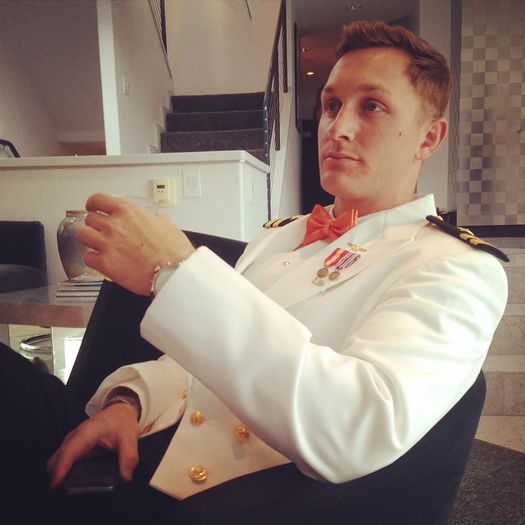NATHAN T. POLOSKI, LT, USN
Nathan Poloski '09
Lucky Bag
From the 2009 Lucky Bag:
Nathan Poloski
Lake Arrowhead, California
"Oh Nathan" are probably the most common words pieced together the life you lived at the Naval Academy. Whether it was doing well in academic classes despite neglecting all your homework or aww-ing all innocent bystanders at sorority parties, you, Nathan Poloski, have provided no shortage of stories to make you the blunt of all joking. There's something about foreign girls; Swedish ("ah the Swedes"), Russian, and high-schoolers that make a wannabe jet jockey race through DC, Annapolis, and the entire Eastern Seaboard in his grandpa-funded (ok, only partially… well, mostly) BMW M3 aka Vesper (really?). Shall we forget waking up your roommates at 0530 with your yoga, disappearing for hours at the gym, and those weird feminine noises were just some of many phases as the young child grew into a techno loving, webcam obsessing man. No you are not Daniel Craig, but I wouldn't want to owe you any money. Hope you will still be able to share you facial cream with members of 10th Company at flight school… that is unless you change your mind about service selection between now and then. AIRBORNE!

Nathan Poloski
Lake Arrowhead, California
"Oh Nathan" are probably the most common words pieced together the life you lived at the Naval Academy. Whether it was doing well in academic classes despite neglecting all your homework or aww-ing all innocent bystanders at sorority parties, you, Nathan Poloski, have provided no shortage of stories to make you the blunt of all joking. There's something about foreign girls; Swedish ("ah the Swedes"), Russian, and high-schoolers that make a wannabe jet jockey race through DC, Annapolis, and the entire Eastern Seaboard in his grandpa-funded (ok, only partially… well, mostly) BMW M3 aka Vesper (really?). Shall we forget waking up your roommates at 0530 with your yoga, disappearing for hours at the gym, and those weird feminine noises were just some of many phases as the young child grew into a techno loving, webcam obsessing man. No you are not Daniel Craig, but I wouldn't want to owe you any money. Hope you will still be able to share you facial cream with members of 10th Company at flight school… that is unless you change your mind about service selection between now and then. AIRBORNE!
Obituary
From Fox 5 San Diego on September 27, 2014:
SAN DIEGO - It is the sound no parent ever wants to hear; the sound of a 21-gun salute means a service member is gone. But for Lieutenant Nathan Poloski's family, there was comfort Saturday afternoon as hundreds of people gathered to honor the loved one they lost during a ceremony at MCAS Miramar.
His family said Nathan died doing what he loved...flying. He had gone to his first military air show at just two years old and he grew into a strong, young man who lived his dream to be a Navy fighter pilot.
His sister said although she was his big sister and he was her baby brother, she looked up to him like a big brother and often found herself living through him.
"As a young girl with him, I went to the air shows and I had a passion for flying and when he got to do it, it was almost like I was living a childhood dream I would never fulfill," Jacqueline Clements said. "He lived his dream."
Any of the people you asked at the memorial service would likely say the 26-year-old Navy pilot died too soon.
But they'd also tell you the United States Naval Academy graduate lived each day of his life to the fullest.
"He was warm and smart," his aunt Tina McEvoy said. "Funny, he loved life and lived it to the fullest and the outpouring of support and love has meant an enormous amount to his family."
In addition to family members honoring him during the private ceremony, his superiors spoke highly of him too.
United States Navy Captain Gregory Keithley shared encounters he'd had with Lieutenant Poloski, calling his passion to fly and eagerness to help others contagious.
United States Navy Commander Michael Langbehn wrote toughing words about the Navy pilot he'd lost while aboard the USS Carl Vinson, but since the squadron had to continue on their mission, CAPT Keithley read his remarks during the service.
Lieutenant Nathan Poloski's sister spoke about her brother, making people laugh, smile and cry. She admitted it wasn't easy to do.
"For the last two weeks, I've thought about him; thought about our memories, stories everything," Jacqueline Clements said. "It all became a blur, because I felt like I had so much to say. I didn't know where to start."
So she started at the beginning...sharing some of her earliest childhood memories of her brother.
Now, she'll have to hold him close in a new way. Commander Langbehn's wife gave Clements a necklace.
"It's something that makes me feel connected to him," she paused. "Because I don't have anything else."
But she does have support and that is something the family has thanked people for over and over again. People they don't even know have taken the time to send them cards and words of encouragement.
Saturday hundreds gathered with them, wiping away tears, smiling at fond memories of Nathan...and together, looking toward the sky as pilots flew the missing man formation.
Nathan has a memory marker in California.
Photographs
from Find A Grave
News
On May 11, 2015 the New York Times used Nathan's loss as an example of the inherent hazards of naval aviation:
A Navy Pilot’s Death Reflects the Everyday Hazards of the Job
WASHINGTON — All the Navy recovered after Lt. Nathan Poloski’s fighter jet collided in midair with another Navy jet on a training mission in the western Pacific in September were his flight helmet and a few bits of debris. The 26-year-old pilot, who was deployed aboard the aircraft carrier Carl Vinson, died one month before the ship steamed into the Persian Gulf and began launching combat missions against the Islamic State.
Lieutenant Poloski’s body and his F/A-18C Hornet were never found in waters nearly three miles deep. The other Hornet pilot was rescued after ejecting from his burning jet. Navy officials concluded that the crash shortly after takeoff was a tragic accident and assigned no blame.
Since the Sept. 11, 2001, terrorist attacks, the United States has focused largely on the thousands of American casualties suffered in the grinding ground combat in Iraq and Afghanistan. But while tiny in comparison, the number of fatal aviation accidents — in combat and in training — illustrates the everyday hazards facing American military pilots and aircrews around the globe.
The Navy’s investigation into Lieutenant Poloski’s fatal crash — a copy of which was obtained by The New York Times through a Freedom of Information Act request after it was completed last month — reveals new details about the collision as well as larger insights into the dangerous business of carrier operations, even when a ship and its aerial armada are not at war.
What remains a mystery, though, is exactly what caused the accident. It was a clear afternoon with good visibility. Both pilots were healthy, properly rested and under no unusual stress. Investigators found no mechanical problems.
The Navy’s top aviator concluded in his review of the eight-page accident report that the two pilots, and several others in the vicinity, should have exercised more of what the military calls situational awareness, or S.A. — in this case, relying not only on an instrument-packed cockpit but also on looking outside to spot a looming catastrophe.
“While there is no definitive evidence to suggest either pilot’s S.A. or lack thereof directly contributed to this incident, greater S.A. by all parties may have prevented the collision,” Vice Adm. Mike Shoemaker, the senior aviator and an F/A-18C pilot, wrote on April 20 in closing the inquiry. The admiral broadened the inquiry’s original conclusion that admonished only Lieutenant Poloski for lacking situational awareness.
Lieutenant Poloski, a Naval Academy graduate from Lake Arrowhead, Calif., who was on his first deployment, became one of four naval aviators to die in accidents in 2014 — a roughly average figure for the Navy in the past several years. Two airmen have died so far in the 10-month campaign against the Islamic State: an Air Force pilot whose F-16 crashed in Jordan in November and a Marine who died in October after bailing out of an Osprey aircraft over the Persian Gulf near Kuwait.
In some cases, military aviation accidents have been spectacles in full public view. In 1996, Lt. Cmdr. John Stacy Bates’s F-14A fighter plunged into a Nashville suburb, killing him and four other people.
Some accidents have drawn greater scrutiny than others. In October 1994, one of the Navy’s first female fighter pilots, Lt. Kara S. Hultgreen, died in a training accident off Southern California, rekindling tensions within the military then over the decision to expand some combat roles for women.
The Navy spent about $100,000 to recover Lieutenant Hultgreen’s aircraft, which was found in water about 4,000 feet deep. Investigators concluded that the accident had resulted from a combination of pilot error and mechanical failure.
The collision that killed Lieutenant Poloski did not seize any headlines, but it cast a spotlight on the elite Top Gun fighter pilot fraternity — roughly 560 carrier-based pilots — and their operations.
Born in San Diego, Lieutenant Poloski grew up near the Miramar naval air station. His mother started taking him to Blue Angels air shows before he could walk, inspiring his lifelong enthusiasm for planes.
Growing up, he could not decide whether to become a fighter pilot or a doctor, his mother, Miriam Kendrick, said in a telephone interview. He considered attending medical school after some years in the cockpit, she said.
Like a lot of fighter pilots, Lieutenant Poloski loved fast cars and expensive motorcycles. A garrulous Southern Californian, he ran marathons, surfed and snowboarded. But flying was his passion.
“He loved the speed, the thrill, the fact very few people do it,” Mrs. Kendrick said. “He loved everything about it.”
In April 2014, Lieutenant Poloski became a member of Strike Fighter Squadron 94, the Mighty Shrikes, based in Lemoore, Calif.
Soon after leaving its home port in San Diego last spring, the crew of the Carl Vinson learned that it would join the fight against the Islamic State in the fall. Lieutenant Poloski was Jewish and a student of the Holocaust, and reports of the militants beheading hostages, including Americans, and slaughtering Shiite Muslims because of their faith stirred something inside the young aviator, his mother said.
“He told me, ‘I’m going to take out those bastards,’ ” she said. He never got the chance.
At 5:37 p.m. on Sept. 12, Lieutenant Poloski’s jet roared off the Vinson’s flight deck on a practice bombing mission more than 100 miles out at sea. A junior pilot, he had just over 221 flight hours in the Hornet. One minute earlier, an F/A-18C piloted by a Navy commander from another squadron with more than 2,100 hours in the jet had flown off the same deck to test repairs that had been made on the plane.
According to the accident report, Lieutenant Poloski accelerated to more than 350 miles per hour, climbing to an altitude of 7,000 feet. About 10 miles from the carrier, he turned west and slowed to about 300 miles per hour. He was apparently unaware that the commander, whose name was redacted from the final report for privacy reasons, had flown a similar route.
Around 5:40 p.m., the two planes collided. The commander told investigators he was unaware of the collision, feeling only a “thump” on his left engine. Within seconds, his plane was aflame and spinning wildly out of control. He bailed out and was later plucked from the sea.
Witnesses aboard the Vinson said they saw two fiery objects falling from the sky. Both planes immediately sank into the sea. Two oil slicks quickly formed on the surface; each plane was carrying more than 2,000 gallons of jet fuel.
The search for Lieutenant Poloski over the next 36 hours covered more than 3,000 square miles and involved several ships and aircraft as well as satellite imagery. His recovered helmet “was damaged, including a crack that extended from the bottom right side to the crown with one hole halfway up the crack,” the report said.
Investigators determined that Lieutenant Poloski’s plane “came underneath the bottom left rear” of the other fighter jet. Based on that and the helmet, investigators surmised that he had died of “massive head trauma.”
There were no onboard devices to warn the pilots of the impending collision. Controllers on the carrier were focusing on other jets that were landing. Investigators addressed the lack of situational awareness. “An overreliance on technology can be a disadvantage,” the report said.
Investigators also calculated the cost of the lieutenant’s lost plane: $77,343,287.80.
Six days after the crash, sailors and pilots gathered at the Vinson’s hangar deck for a memorial. Pilots flew a missing man formation — with one jet absent — over the carrier at the end of the ceremony. The Blue Angels, who also fly F/A-18Cs, the Corvette of the skies, later dedicated one of their shows to Lieutenant Poloski.
“He persistently displayed his contagious enthusiasm for our unique profession,” Cmdr. Michael Langbehn, Lieutenant Poloski’s squadron commander, said in an email. “He was determined to do what he must to be the best among us.”
Remembrances
From the Naval Academy Alumni Association's "In Memoriam" page:
One thing is for certain, Nate Poloski lived his entire life full-speed ahead. He undoubtedly packed more into his 26 years of life than one could ever imagine. His intelligence was unmatched. His passion and loyalty was real. He pushed himself to be stronger, smarter, faster, and better dressed than everyone he met, which drove him to ultimately succeed in everything he ever attempted. No one doubted he would fly jets or even be a Blue Angel one day. He climbed mountains, hiked arduous trails, completed triathlons and so much more. He was an inspiration. Should you ever have a big dream or goal in life, think of what Nate would tell you: “What are you waiting for? Let's go!” LT Andrew Poulin '09
Nathan is one of 2 members of the Class of 2009 on Virtual Memorial Hall.

The "category" links below lead to lists of related Honorees; use them to explore further the service and sacrifice of alumni in Memorial Hall.





